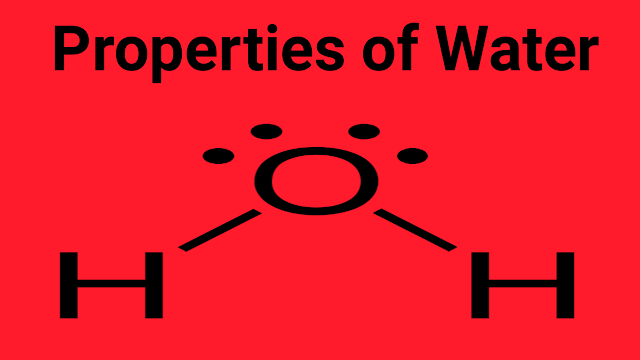Water is one of the basics of life on Earth. Its reason is that without water, life is impossible on Earth. Moreover, drinking water is also helpful for our body in various ways it helps to create saliva, regulates the temperature of the body, protects our tissues and joints, helps to excrete the waste material from our body, it helps to maximize the physical performance of the body, it helps us to lose weight and it can also enhance the circulation of oxygen in the blood. There are some properties and facts about water. Here, we will discuss the properties and facts of water.
Facts of Water
i. Water is the only natural substance that is available in all the physical states i.e. solid, liquid, and gas. Therefore, we can also say that water is a unique substance on Earth.
ii. It is made of Hydrogen and Oxygen and its chemical formula isH2O.
iii. The average amount of water in the human body is from 50% to 65%.
iv. If we are asking for water, it means that we are referring to the liquid state of the water. On the other hand, the solid state of the water is known as ice and the vapor state of the water is known as steam.
v. Water also shows peculiar behavior because its solid form (ice) is less than its liquid form. That’s why ice floats on the surface of the water.
vi. There is a huge amount of slat components in the seawater. That’s why seawater is salty. It is estimated that in every kilogram of seawater, there are 35 grams of salt.
vii. The presence of the salt components in the water increases its freezing point. That’s why the freezing point of seawater is 2 °C rather than 0 °C.
viii. The average amount of water in newly born babies is up to 78%.
ix. The water cycle is responsible for the maintenance of water resources in the world. The water cycle means that water is evaporated from the surface of oceans, rivers, and lakes and it goes into the atmosphere. In the atmosphere, it condenses and falls on the earth in the form of rain and ice. The ice on the surface of the mountains melts and it forms rivers. We are using the water of rivers for various purposes. The rest of the water again goes into the ocean.
x. There is no smell or taste of pure water.
Facts of Water (2nd Phase)
xi. At 0 °C, water freezes. On the other hand, at 100 °C, it evaporates.
xii. We need water to save our bodies from dehydration. The need for water for your body also changes. It means that in the summer, we require more water than in the winter. Our activities also decide the need for water.
xiii. The weight of a gallon of water is 8.34 pounds. If we cover an acre of the earth with one inch of water, its weight will be 27,154 gallons.
xiv. The most important use of water is in the form of agricultural irrigation. It means that we are fulfilling the water needs of crops via artificial ways.
xv. Water is also known as a universal solvent. Its reason is that water can dissolve more substances than any other liquid. Therefore, whether water is present underground or in our body, it contains lots of minerals and other nutrients.
xvi. We are also using water in hydroelectric power generation to generate electricity. There are lots of hydroelectric power generation available in the world. To generate electricity from hydroelectric power generation is known as the cheapest way to generate electricity.
xvii. More than 70% of the earth’s surface is covered with water.
xviii. Pure water is not acidic nor basic because it has a pH scale of 7. On the other hand, acids have a PH scale of less than 7 and bases have a pH scale of more than 7.
xix. 90% of the earth’s water is salty which is present in the form of lakes and oceans. On the other, the rest of the water is trapped in the earth or the glaciers.
xx. Water has also high cohesive properties. That’s why water is a very sticky liquid and it can easily stick to the molecules of other substances.
Facts of Water (3rd Phase)
xxi. The amount of water in the atmosphere is more than the water in the rivers.
xxii. Pure water is not found in the natural environment. It is also an amazing fact that pure water can’t conduct electricity. Therefore, when some substances are added to the pure water, it starts to conduct electricity.
xxiii. If all the water vapors that are present in our atmosphere fell on the surface of the earth at once, these water vapors will cover the surface of the earth up to one inch.
xxiv. The heat index of the water is also very high. It means that it can absorb a large amount of heat. That’s why it is very valuable in the industries and for the radiators of cars.
xxv. If a faucet is dripping and it dips one drop of water in one second, it will waste 3,000 gallons of water in one year.
xxvi. The surface tension of the water is also very high. Due to the high surface tension of the water, it tends to clump together in the form of drops rather than in the form of a thin film. The high surface tension of the water also allows the water to move through the roots of the plants and blood vessels.
xxvii. More than 748 million people in the world don’t have access to fresh resources or water.
xxviii. The air pressure also affects the boiling point of the water. At the higher altitude, the air pressure is low and as a result, the boiling point of the water is also lower.
xxix. If you want to irrigate one calorie of food, you will have to use .26 gallons of water.
xxx. If you want to make a sheet of paper, you will have to use 2.6 gallons of water.
Facts of Water (4th Phase)
xxxi. If you want to produce 2.2 pounds of rice, you will have to use 2,641 gallons of water.
xxxii. To manufacture a new car, you will have to use up to 39,000 gallons of water.
xxxiii. Due to the water cycle, the amount of water remains constant in the world. That’s why instead of lots of uses of water, the amount of water is the same as it was during the creation of the world.
xxxiv. The amount of water in the human brain is almost 75% and the amount of water in a living tree is also 75%.
xxxv. Without food, a person can live alive for more than one month. On the other hand, without water, it is almost impossible for a person to live alive for more than one week.
xxxvi. As we know that most people in developing countries can’t have access to fresh resources of water. That’s why more than 80% of the diseases in developing countries are due to the drinking of impure water.
xxxvii. Water also plays a vital role in regulating the temperature on Earth.
xxxviii. If we collect the whole water resources on the earth in a four-liter jug, the amount of freshwater will be equal to a tablespoon.
xxxix. NASA has also discovered water resources on the Moon but these water resources are found in the form of ice.
XL. If you are taking a shower for 5 to 10 minutes, it means that you are using 10 to 25 gallons of water.
XLi. The sun evaporates almost a trillion tons of water every day.
XLii. If you are suffering from a fever, you should try to drink as much water as you can. Its reason is that by drinking a huge amount of water, you can regulate the temperature of your body.
XLiii. 1.7% of the earth’s water resources are permanently frozen. Therefore, these resources of water are not useful for us.
XLiv. US residents are using almost 400 billion gallons of water daily.
XLV. By drinking impure water, almost 200 children are dying every hour.
Properties of Water
i. Molecular Formula
.








